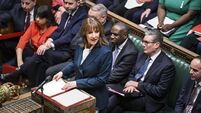David McNamara: British economy is stuck in stagnation

For the optimists, solid retail sales figures for January suggest the British consumer is recovering some momentum.
A plethora of British data last week provided conflicting evidence on the strength of the economy of late: For the optimists, continuing strength in the labour market and solid retail sales figures for January suggest the British consumer is recovering some momentum.
However, sticky inflation and moribund GDP growth point to a wider malaise in the economy.
In the labour market, unemployment fell to 3.8% in December, down from 4.2% a month earlier. Regular earnings growth — a key benchmark for the Bank of England — also slowed to 6.2% from 6.7% and is now on a clear downward trajectory.
However, with core inflation stuck at 5.1% for a third month running in January, a still-tight labour market remains the primary driver of relatively high UK inflation.
To add to the uncertainty, measurement issues with the British labour market data provide a large caveat in interpreting the strength of the UK jobs markets at present.
Nevertheless, markets digested this news by trimming expectations for Bank of England rate cuts this year to about 70 basis points by the end of this year, down from reductions of 75 basis points at the start of last week, underpinned by a stronger-than-expected print for retail sales in January, which were up 3.4% on the month.
However, the fourth-quarter GDP data provided further evidence of a longer-term trend of stagnation in the UK economy. GDP declined by 0.3% on the quarter, rounding off a calendar year growth of just 0.1% in 2023, and the British economy is now just 1% above its pre-covid level in the final quarter of 2019.
This compares to the 3% and 8.2% growth rates in the eurozone and US, respectively, during that same period, highlighting the relatively weak trajectory of the UK economy in recent years.
With the labour market beginning to show signs of weakness, reflected in recent industry surveys, and inflation expected to slowly moderate to its 2% target, the Bank of England should be on course to begin cutting rates later this year in line with the other central banks, which should provide a boost to growth in the near term.
On the main currency markets over the past week, sterling versus the dollar was the main mover, with markets reacting to the UK economic news. However, the sterling gains earlier in the week were largely given back by the end of the week.
Turning to the week ahead, the main release of note will be the flash purchasing managers' indices for February in the eurozone, US and UK.
In the eurozone, the managers' indices have been in contraction mode for a number of months. However, the manufacturing index has edged higher over the winter.
Meanwhile, the services sector reading has been little changed. Despite some modest improvement this month, both sector readings are expected to remain consistent, with declining activity.
- David McNamara is chief economist at AIB













